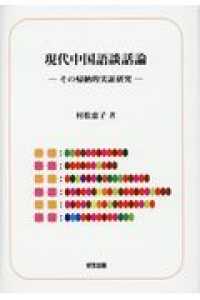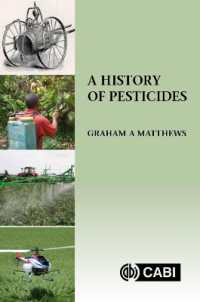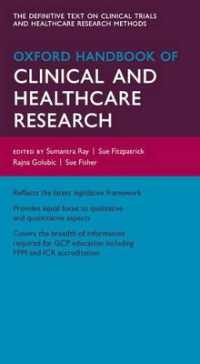- ホーム
- > 洋書
- > 英文書
- > Nature / Ecology
Full Description
This book presents a global overview of the background to, and the current state of, crop protection and pest management in cotton crops. Cotton is one of the most economically important crops in the world and has been grown for centuries but maintaining high yields of good quality requires sophisticated approaches to pest management. The introduction and use of pesticides over the decades significantly increased cotton yields but lead to many adverse environmental impacts. Over time, new and alternative insecticides were developed but overuse has enabled pests to develop significant resistance. The development of genetically modified cotton varieties with toxins derived from Bacillus thuringiensis enabled much improved control of lepidopteran larvae, including bollworms, but as the toxins had no effect on sucking pests, farmers had no choice but to continue using insecticides. Also, some of the new cotton varieties developed in recent times have not adapted to different climatic conditions and the quality of cotton fibre declined as a result. This book shows the need for more research to select cotton varieties with high quality fibres suitable for different cotton growing areas and to develop integrated pest management strategies to minimise the use of pesticides. It also demonstrates the need for an inter-disciplinary approach bringing together plant breeders, entomologists, plant pathologists, agronomists and agricultural engineers to achieve high yields of high quality cotton. In the future, farmers will need to adopt new technology to determine when and how pesticides are used in conjunction with cultural and biological control strategies. · Emphasises the importance of research on growing cotton in a world experiencing climate change · Demonstrates how crucial crop protection is in achieving high yields of high quality cotton · Shows how new technology will bring major changes in how cotton is grown in the future
Contents
1: Origins of Cotton. Graham Matthews 2: Cotton in the United States of America and Mexico. C.T. Allen, Steven M. Brown, Charlie Cahoon, Keith Edmisten, Rogers Leonard, T. Miller, Jane Pierce, Dominic Reisig and Phillip Roberts 3: Cotton Growing in India. V.N. Waghmare, M.V. Venugopalan, V.S. Nagrare, S.P. Gawande and D.T. Nagrale 4: Cotton Growing in Pakistan, Bangladesh and Myanmar. Abid Ali, Zeeshan Ahmed and Zheng Guo 5: Growing Cotton in China. Lu Zhaozhi, Li Xueyue, Zhang Wangfeng, Zheng Juyun, Liang Fei, Yang Desong, Tian Jingshan, Gao Guizhen, Wang Juneduo and Abid Ali 6: Uzbekistan and Turkmenistan. Bahodir Eshchanov and Shadmon E. Namazov 7: Cotton Growing Along the Nile (Egypt and Sudan). Graham Matthews 8: Cotton in Southern Africa (Zimbabwe, South Africa [Eswatini], Malawi, Zambia, Mozambique and Angola). Graham Matthews and John Tunstall 9: Cotton Growing in East Africa (Tanzania, Ethiopia, Uganda and Kenya). J. Kabissa, Pius Elobu and Anthony Muriithi 10: Cotton Growing in West Africa (Mali, Burkina Faso, Côte d'Ivoire, Senegal, Benin, Togo, Niger, Cameroon, Nigeria and Ghana). Germain Ochou Ochou, S.W. Avicor and G.A. Matthews 11: Cotton Growing in Australia. Graham Matthews and Paul Grundy 12: Cotton Growing in South America and the Caribbean (Brazil, Argentina, Peru, Paraguay, Colombia and the Caribbean). Simone Silva Vieira and Graham Matthews 13: Cotton Growing Around the Mediterranean (Turkey, Greece, Spain and Israel). Feza Can, Cafer Mart, Berkant Ödemis¸ and Yas¸ar Akis¸can 14: A Look Forward. Graham Matthews








